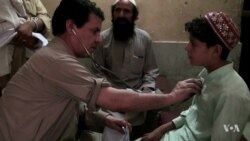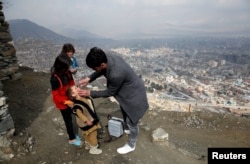The move to end polio started in 1985 with Rotary International. At that time, polio paralyzed hundreds of thousands of children every year. There is still no cure, but two scientists developed vaccines against the virus in the 1950's.
Dr. Jonas Salk produced one with an inactivated virus that could protect against polio without spreading the disease. Later, Dr. Albert Sabin developed an oral vaccine with weakened strains of the virus.
In 1988, public and private groups joined the effort in the Global Polio Eradication Program. Members included governments, the World Health Organization, the United Nations Children’s Fund (UNICEF), Rotary International, the U.S. Centers for Disease Control and Prevention (CDC) and the Bill and Melinda Gates Foundation.
Since then, the number of polio cases has dropped by 99.9 percent. Last year, 22 children were crippled by this disease. The wild polio virus exists in only three countries: Pakistan, Afghanistan and Nigeria, but it's still a global threat.
Dr. John Vertefeuille, from the CDC said, "This last mile is a complicated mile." It’s not just because of conflict or terrorism. "It’s extreme remoteness. It’s very fragile health systems." And in these remote conflict prone areas gaining access to children can be a major problem.
If polio exists anywhere, it can once again spread everywhere.
Vertefeuille and other experts discussed strategies to realize a polio-free world July 10 at the Center for Strategic and International Studies in Washington.
Widespread unrest in Afghanistan has kept thousands of children from receiving polio vaccines this year. Conflict in northern Nigeria does the same.
What's more, the border between Afghanistan and Pakistan stretches for more than 2,000 kilometers. Thousands of people who cross this very porous border can easily transmit the virus in both countries.
While the funding and technical support has to come from large, private-public partnerships, immunization teams succeed best if they are local. Approaches have to take culture and customs into consideration.
In many places the vaccinators are women because women can go into the homes, talk to other women and gain access to the children.
Elsewhere, soldiers vaccinate children when they take over an area run by anti-government forces. Vaccination teams have to be prepared to move quickly when there is a lull in the fighting and to deliver multiple doses of vaccine in a short period of time.
Surveillance is just as critical. To end polio, you have to know where the outbreaks are. Community volunteers are a great resource. Some get cell phones so they can alert health officials if a child becomes paralyzed.
Another challenge is getting children in migrant groups vaccinated. Vertefeuille says this is where technology helps. The CDC uses satellites to see where people have moved and what areas are abandoned. Clues are where structures have been repaired, where the grass grows on roads, indicating abandoned areas, and where it doesn't, indicating where people are living.
Dr. Andrew Etsana from the International Federation of Red Cross and Red Crescent Societies said these groups present a particular challenge because "you have people moving with a virus and it is difficult to track them and vaccinate the vulnerable children in this mobile population.”
Another issue is the nature of viruses themselves. Viruses mutate. So far, the polio vaccines have been effective, but if not enough children get vaccinated, the virus can change, and perhaps make the vaccine less effective. That's why every child needs to be vaccinated.
Outbreaks that can be avoided by vaccinating the whole population so that there are no gaps for the mutated virus to slip through.
International experts are working with local leaders to close this gap.
Another issue is complacency. Etsana said, "People are getting tired. The program has been going on. They thought it would have ended."
Rotary has pledged to continue its support, other groups as well. International support and funding is critical to ending polio, but after three decades, many people have never seen polio. Etsana says he sees complacency creeping into all areas of the program. "The funders of the program are also getting tired. The fund is drying up and if the fund dries up and the job is not done, we’re going to have a major problem. We may have reinfection.”
But, if people recognize the program's value - it has united communities, established vaccine centers, created partnerships never before imagined - the world can not only end polio, but tackle other diseases as well. The polio program is widely credited with stopping the spread of Ebola in Nigeria while the disease ravaged other west African countries.






